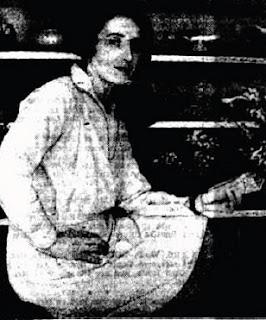|
|
|
|
|
|
Designer
|
John
Barnard Knight
|
Maker
|
John
Barnard Knight
|
Marks
|
Incised
“Janet Grey Studio” to unglazed base.
|
Description
|
Small
mould formed steep sided bowl with mainly crown shaped ornamented handles
angled down the outside. Harlequin
interiors with plain gloss glazed exteriors.
|
Condition
|
Some
age related cracking due to thickness of material. Crazing to interior glaze.
|
Number
|
|
Production
Date
|
1954
|
Width
|
87mm
|
Depth
|
45mm
|
Length
(with handle)
|
130mm
|
Weight
|
160gm
|
Volume
|
200ml
|
Acquisition
|
Australian Pottery at Bemboka
|
Rameking
Reference Number
|
BAK
006
BAK
007
BAK
008
BAK
009
|
|
|
|
|
In February 1954, the young Queen Elizabeth became the first reigning monarch to visit Australia. The Rameking was there perched on his fathers shoulders to get a look at the royal couple. Hard to believe today, but the whole country went crazy during the tour, how some things change. I still have the small Australian flag that I waved.
Souvenirs were made and sold by the million and among the seemingly endless flow of tat, were these ramekins made to cash in on the frenzy. Made to his standard bowl shape with the crown shaped handle added as a bit of relevance, thus making dating easy.
John Arthur Barnard Knight was born in
Warracknabeal, Victoria on the 9th of April 1910. His parents were Arthur Knight and Mabel
Alice Barnard. He was active from the early 1930s to the late 1970s. During
most of this time, he taught pottery at what is now the Royal Melbourne
Institute of Technology (RMIT). Prior to this, he and Klytie Pate had worked at
Hoffman following their introduction of “Melrose” ware in 1930.
John had
previously studied art at what was then the School of
Applied Art at the Melbourne Technical School; it is now the RMIT
University. He also studied the
production methods at the pottery at Hoffmann Bricks in Brunswick and at the
nearby Maribyrnong Potteries. He worked
in the studio of Napier Waller from 1932-33.
After
graduating, he and Klytie joined the staff, teaching pottery, modelling and
drawing. She left
after ten years while he continued on until 1975. In 1939, he took charge of the Pottery
Department. In 1940 he married Isabel Gwenda Grose, one of his students, and
they established the Janet Grey Studio at South Yarra. They lived nearby at 43
Thanet Street Malvern.
He served in
the RAF from 1942-1945, then continued to expand the Janet Gray Studio and to
re-organise the teaching of pottery at the school, establishing courses for the
Commonwealth Reconstruction Training Scheme, and upgrading classes to
certificate and diploma courses in 1949 and 1950. He is best known as an
educator, continuing to teach at RMIT until 1975. His own work is signed 'J. A.
Barnard Knight (painted or incised).
He was a man of
firm opinion. An example of the can be found in “ACROSS THE DITCH: Australian Ceramics in the Post War
Period; It was at the Royal Melbourne Institute of Technology that Peter
Rushforth, who had spent some years as a prisoner of the Japanese, was
introduced to Leach's book (A Potter's Book ) by the ceramics teacher Jack Knight. As a firm believer in earthenware,
Knight found this interest in stoneware and oriental ceramics difficult to
comprehend; he sat outside in the sun reading a newspaper while Hamada
demonstrated at RMIT in the 1960s, saying that they were 'always talking about
stoneware ... can't understand them.”
John also had his workshop in Malvern, a south-eastern suburb
of Melbourne where he sold his work under several pseudonyms, one of these
being "Janet Grey". I do not
know how he arrived at the name, but Dr Janet Grey was responsible for the now
defunct milk for school children program in Victoria. John retired with his wife to Flinders on Victoria’s Mornington
Peninsula. He died in Victoria in 1993.
























